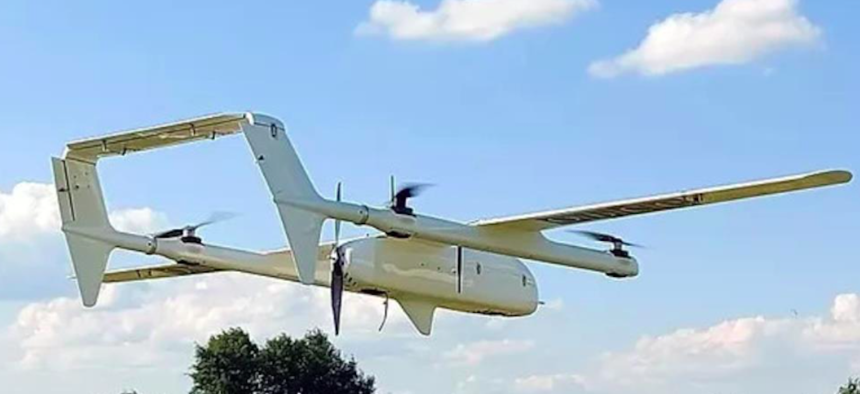PATRICK TUCKER

A family of drones designed to operate against extremist groups is proving effective against the Russian military, and their manufacturer is quickly working to upgrade them with information from the Ukrainian troops putting them to use. But even company officials caution that drones won’t serve as a substitute for the larger weapons Ukraine needs.
Cyprus drone-maker Swarmly has already sent about 50 drones to Ukraine, a company official told Defense One. The smaller is the Poseidon H10 with a 3.5-meter wingspan, two-hour endurance, and 8-pound payload. The larger is the Poseidon H6, a gasoline/electric propulsion hybrid with a five-meter wingspan, 7-hour endurance, and 50-pound payload.
All 50 were purchased with private donations.
“Certainly, the government of Ukraine never bought anything from us,” the Swarmly official said.
Swarm's drones represents the future of drone manufacture in a couple of important ways. They don’t come armed, which avoids a lot of legal and trade barriers, but they can rather easily be rigged to carry weapons (though this does void the warranty). And unlike hobby drones, they can even withstand some jamming.
“The design itself was built to work in low-intensity conflicts against enemies like ISIS, Boko Haram, or something similar,” the Swarmly official said. “Those organizations acquire pretty sophisticated weaponry and electronic warfare stuff, mostly from China. So basically, we designed our systems to withstand that. All these bad guys are buying [Global Navigation Satellite System] jammers on AliExpress for 500 bucks, and they instantly have satellite positioning denial within a 10-kilometer radius. So we basically designed all our systems to work in these kinds of environments,” he said. “What really surprised us is that Russians weren’t much more sophisticated than Boko Haram.”
“We started getting information from the Ukrainian troops that used our systems and getting reports on the sorts of anti-drone techniques the Russians are using. We can see [the Russians] are using chirp jammers, which are actually pretty dangerous for those systems that were not designed to withstand them. We know exactly where they bought those chirp jammers. Maybe they added a power amplifier or something to make the coverage areas larger. But we immediately recognized what that is. And we know exactly which Aliexpress [online retailer] store they bought this from.”
The Swarmly drones remain susceptible to more advanced air defenses, such as missiles fired from S-300 or S-400 batteries, but the cost of such missiles is more than the cost of one of the company’s drones.
One Ukrainian combat veteran who now works with the company told Defense One, “There are two things that are really important for a tactical UAV in this war: standing up to the enemy and friendly jamming, and high-resolution optics. Poseidon has both of these.”
The company plans to put out a larger drone with a 200-pound payload in early 2023. And they’re expanding their Cyprus plant, which currently makes about 150 drones a year, to produce more than 350.
The company plays up its anti-jamming abilities, asserting in materials that data from the field shows that the “highest number of aircraft losses” are mid- and long-range consumer drones that lack such abilities.
But the official also warned that no relatively lightweight drone will be a silver bullet for Ukraine.
war“I think the use of drones as combat system in the high-intensity conflict is greatly overhyped because the payload capacity is not there to cause significant damage unless you create something like what the Iranians are using [with the Shahed-136]: a loitering munition with a 100-pound warhead to strike stationary targets,” the official said.
No comments:
Post a Comment